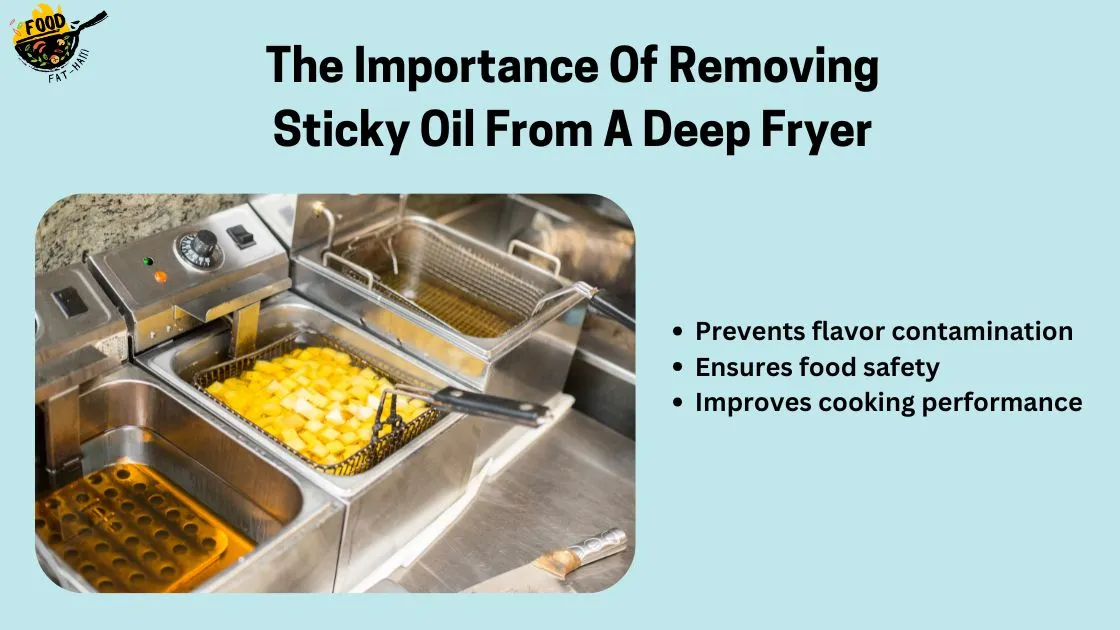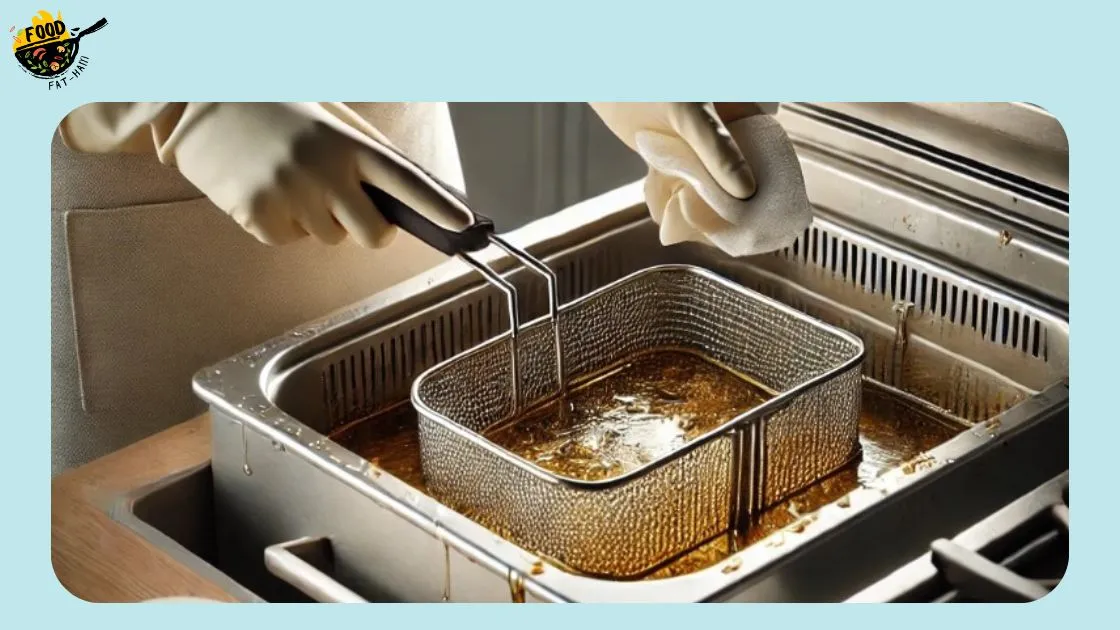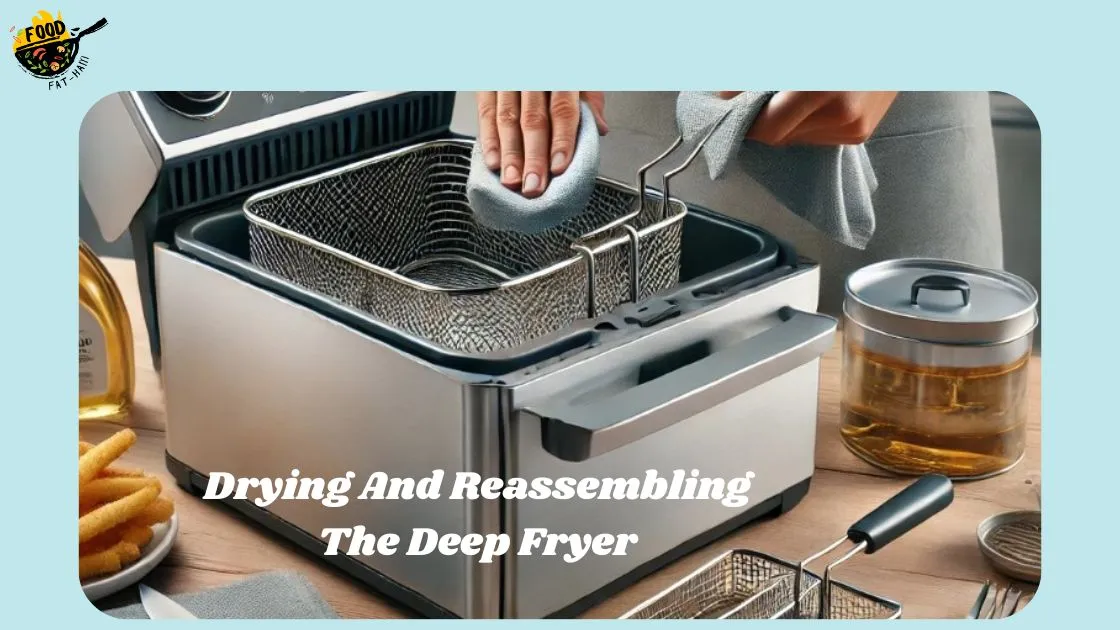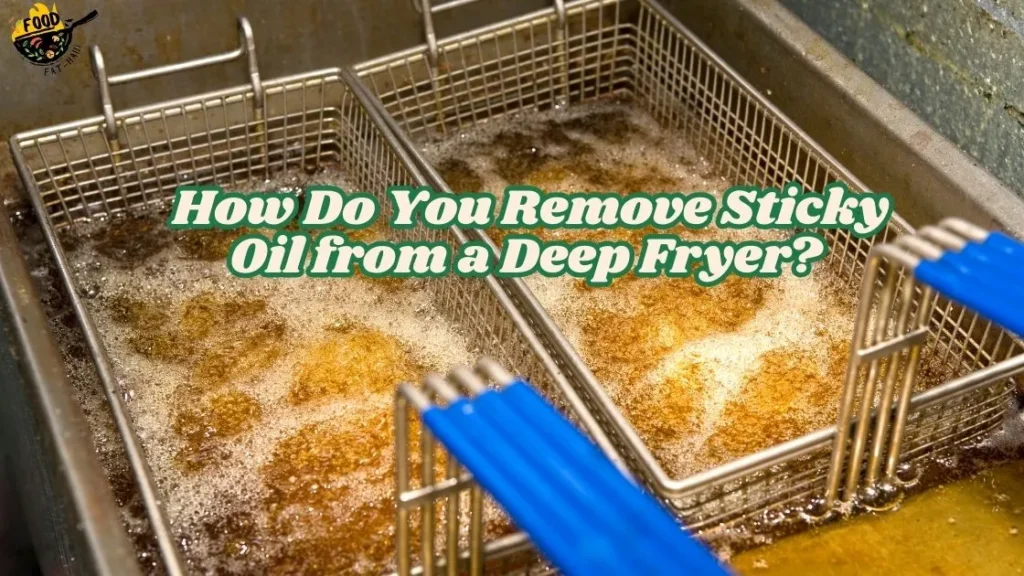To remove sticky oil from a deep fryer, you can use a mixture of warm water and dish soap. Soak a sponge or cloth in the soapy water and then scrub the affected areas of the fryer until the oil is removed.
Table of Contents
ToggleMaintaining a clean and efficient deep fryer is essential for ensuring the quality and taste of your fried foods. Unfortunately, the accumulation of sticky oil can be a common problem that not only affects the flavor of your dishes but also poses a potential fire hazard.
When it comes to tackling this issue, there is a simple and effective solution. By using a combination of warm water and dish soap, you can easily remove sticky oil from your deep fryer. We will explore the step-by-step process of cleaning your deep fryer and ensuring it is free from any residual oil. So let’s dive in and discover the best method to remove sticky oil from your deep fryer.
Understanding The Sticky Oil Problem
Looking to remove sticky oil from a deep fryer? Discover effective solutions and tips for understanding and tackling the sticky oil problem with ease.
The Importance Of Removing Sticky Oil From A Deep Fryer
Deep fryers are a staple in many kitchens, providing a quick and convenient way to prepare crispy and delicious fried foods. However, over time, the oil used in these fryers can become sticky and prone to buildup. Understanding the sticky oil problem is crucial for maintaining the longevity and efficiency of your deep fryer.

Let’s explore why it is essential to remove sticky oil from a deep fryer.
- Prevents flavor contamination: When oil becomes sticky, it can easily attract food particles and debris, leading to flavor contamination. This can result in off-flavors and unpleasant tastes in your fried foods, compromising their quality.
- Ensures food safety: Sticky oil can become a breeding ground for bacteria and other microorganisms. If left unattended, these contaminants can multiply, posing a significant health risk when the oil is reused for frying. Regularly removing sticky oil helps maintain the cleanliness of the fryer, ensuring the safety of the food you prepare.
- Improves cooking performance: Sticky oil can hinder the cooking performance of your deep fryer. The gunk and residue that accumulate in the fryer can create uneven heat distribution, resulting in inconsistent cooking times and textures. By removing sticky oil, you allow the fryer to operate at its optimal capacity, producing evenly cooked and delicious fried foods.
Common Causes Of Sticky Oil In Deep Fryers
Understanding the common causes of sticky oil in deep fryers can help you prevent this issue and maintain a clean and efficient frying environment. Here are some potential culprits:
- Moisture and food particles: When moisture or food particles come into contact with hot oil, they can interact and create sticky substances. This can occur when frying foods with high water content, such as battered or breaded items. The moisture and crumbs from these foods can combine with the oil, leading to a sticky residue.
- Overheating: Excessive heat can cause the oil to break down and become sticky. When the oil reaches its smoke point, it starts to degrade and form polymers that contribute to stickiness. Overheating the fryer or using oil beyond its recommended temperature range can accelerate this process.
- Poor oil quality: The quality of the oil you use plays a significant role in stickiness. Reusing oil too many times or using low-quality oils can lead to the formation of sticky residues. Additionally, oils with high levels of saturated fats are more prone to becoming sticky.
The Risks Of Leaving Sticky Oil Unattended
Leaving sticky oil unattended in your deep fryer can have several negative consequences. Here’s why it’s important to address the sticky oil problem promptly:
- Increased fire hazard: Sticky oil is highly flammable, and the accumulation of debris and residue can increase the risk of a fire in your kitchen. Ignoring the sticky oil issue may put your safety and the safety of others at risk.
- Reduced oil lifespan: When oil becomes sticky, it becomes less effective at frying. The debris and particles in the oil can lower its smoke point and increase the chances of burning or producing off-flavors. Regularly removing sticky oil can help prolong the lifespan of your frying oil.
- Impaired food quality: Sticky oil can negatively impact the quality of your fried foods. It can result in uneven frying, making some parts overcooked while leaving others undercooked. Additionally, the sticky residue can transfer unwanted flavors to your food, affecting its taste and texture.
By understanding the importance of removing sticky oil from your deep fryer, the common causes of stickiness, and the risks of leaving it unattended, you can take the necessary steps to maintain a clean and efficient frying environment. Regular maintenance and proper cleaning techniques are key to enjoying delicious and perfectly fried foods every time.
Preparing The Deep Fryer For Cleaning
To prepare your deep fryer for cleaning, start by removing all oil and frying residue from the fryer. Use a degreaser or hot, soapy water to remove sticky oil, and scrub with a sponge or brush. Rinse thoroughly and allow to dry before using again.
Ensuring Safety: Turn Off And Unplug The Deep Fryer
Before diving into the task of cleaning your deep fryer, it is crucial to prioritize safety. Here’s what you need to do:
- Make sure to turn off the deep fryer by flipping the switch or pressing the power button.
- Unplug the fryer from the electrical outlet to prevent any accidental mishaps.
Removing Excess Oil And Debris

To effectively clean your deep fryer, you’ll want to start by eliminating any excess oil and debris. Follow these steps:
- Allow the deep fryer to cool down completely. This will prevent any potential burns.
- Carefully remove the frying basket from the fryer and set it aside.
- Use a slotted spoon or a heat-resistant spatula to skim off any loose debris floating on the surface of the oil.
- If there are any solid particles stuck to the interior of the fryer, gently scrape them off using a non-abrasive sponge or brush.
- Wipe the interior of the fryer with a paper towel to remove any remaining oil or residue.
Safely Discarding Used Oil
Properly disposing of used oil is essential for maintaining the hygiene of your deep fryer. Consider the following steps:
- Allow the oil to cool down completely before attempting to dispose of it. Hot oil can cause severe burns.
- Use heat-resistant gloves or mitts to carefully pour the used oil into a sealable container or an empty plastic bottle.
- Do not pour the oil down the drain, as it can cause clogs and damage to plumbing systems. Instead, check local regulations for proper disposal methods.
- Seal the container tightly and place it in a trash bin designated for oil or grease disposal.
- Remember to clean the fryer after disposing of the oil to ensure a fresh, optimal cooking experience the next time you use it.
With safety precautions in place and excess oil and debris removed, you are now ready to proceed with a thorough cleaning of your deep fryer.
Effective Techniques For Removing Sticky Oil
Discover effective techniques to remove sticky oil from a deep fryer. Learn how to tackle this stubborn problem easily and efficiently, ensuring a clean and functional appliance for your cooking needs.
If you find yourself dealing with the challenge of removing sticky oil from your deep fryer, fret not! There are effective techniques you can employ that will make the task a breeze. Here, we will discuss three proven methods: using hot water and dish soap, utilizing baking soda and vinegar, and applying a commercial deep fryer cleaner.
Read on to discover how each of these techniques can help you restore your deep fryer to its original, pristine condition.
Using Hot Water And Dish Soap

- Fill the deep fryer with hot water: Make sure the deep fryer is unplugged and has cooled down before proceeding. Fill the fryer with hot water until it reaches the maximum oil level line.
- Add dish soap: Add a few drops of dish soap to the water. The soap will help break down and dissolve the sticky oil residue.
- Let it sit: Allow the water and dish soap mixture to sit in the deep fryer for about 30 minutes. This will allow the soap to work its magic and loosen the sticky oil.
- Scrub away the residue: After the soaking time has elapsed, use a sponge or a soft brush to scrub away the sticky oil residue. Focus on the areas where the oil has solidified the most.
- Rinse thoroughly: Finally, rinse the deep fryer with clean water multiple times to remove any remaining soap residue.
Utilizing Baking Soda And Vinegar
- Create a paste: In a small bowl, mix equal parts baking soda and vinegar until it forms a thick paste. The combination of these two ingredients creates a powerful cleaning agent.
- Apply the paste: Using a sponge or soft brush, apply the paste to the areas of the deep fryer affected by sticky oil. Be sure to cover all the oil residue.
- Let it sit: Allow the paste to sit on the surface for approximately 15-20 minutes. This will give the baking soda and vinegar time to break down the stickiness.
- Scrub gently: With a sponge or soft brush, gently scrub the surface of the deep fryer. Apply a little extra pressure to stubborn areas, but be careful not to damage the fryer’s coating.
- Rinse thoroughly: Once you have finished scrubbing, rinse the deep fryer with clean water to remove any residual baking soda and vinegar.
Applying A Commercial Deep Fryer Cleaner

- Choose a suitable deep fryer cleaner: Purchase a reliable commercial deep fryer cleaner from a reputable retailer. Make sure it is compatible with your deep fryer model.
- Read the instructions: Before proceeding, carefully read and follow the instructions provided by the manufacturer of the deep fryer cleaner. This will ensure proper usage and effectiveness.
- Apply the cleaner: Apply the deep fryer cleaner according to the instructions. Typically, you will need to spray or directly apply the cleaner onto the affected areas.
- Allow it to work: Give the cleaner some time to penetrate and dissolve the sticky oil residue. Follow the recommended waiting period specified by the manufacturer.
- Wipe away the residue: Once the waiting period is over, use a sponge or cloth to wipe away the residue. Ensure that you remove all the cleaners from the deep fryer.
- Rinse thoroughly: To eliminate any leftover residue, rinse the deep fryer thoroughly with clean water. This will leave your deep fryer sparkling clean and ready to use.
By employing these effective techniques, you can easily remove sticky oil from your deep fryer, ensuring it remains in pristine condition for your next culinary masterpiece.
Scrubbing And Rinsing The Deep Fryer
To remove sticky oil from a deep fryer, start by scrubbing the interior surfaces with a non-abrasive sponge or brush. Next, rinse the fryer thoroughly with hot water to remove any remaining residue. Repeat these steps as needed to ensure a clean and oil-free fryer.
Cleaning the Fryer Basket and other Removable Parts:
- Remove the fryer basket and any other removable parts from the deep fryer.
- Wash the basket and parts with warm soapy water, using a non-abrasive sponge or cloth.
- Scrub away any sticky oil residue on the basket and parts, paying extra attention to the corners and crevices.
- Rinse the basket and parts thoroughly to remove all soap residue.
- Dry them completely before placing them back into the deep fryer.
Using Non-abrasive Materials to Avoid Damaging the Fryer:
- When scrubbing the deep fryer itself, avoid using abrasive materials such as scouring pads or metal brushes.
- Use a non-abrasive sponge or cloth to gently scrub the interior and exterior surfaces of the fryer.
- For stuck-on oil or stains, create a paste using baking soda and water, then gently scrub with a non-abrasive sponge.
- Be mindful not to scratch or damage the fryer while cleaning.
Thoroughly Rinsing the Fryer to Remove All Residue:
- After cleaning with soap or baking soda, rinse the fryer thoroughly with warm water.
- Make sure to remove all soap or baking soda residue by rinsing multiple times.
- Pay attention to hard-to-reach areas, such as the heating element or corners of the fryer.
- Allow the fryer to air dry completely before using it again.
- Double-check that there is no residual oil or cleaning solution left before frying food.
Remember, maintaining a clean deep fryer is essential for both the taste of your food and the longevity of the appliance. By following these tips for scrubbing and rinsing your deep fryer, you will ensure that your cooking remains delicious and your fryer stays in excellent condition.
Happy frying!
Drying And Reassembling The Deep Fryer
To remove sticky oil from a deep fryer, it is important to thoroughly clean and dry the appliance. After disassembling the necessary parts, wipe off the excess oil and then use warm soapy water and a sponge to clean the interior.

Allow all parts to air dry completely before reassembling the deep fryer.
Once you have successfully cleaned the sticky oil from your deep fryer, it is important to ensure that it is properly dried before reassembling it. This will prevent any moisture or water droplets from compromising the functioning of the fryer.
Follow these steps to dry and reassemble your deep fryer:
Allowing Sufficient Time For The Fryer To Air Dry:
After cleaning the fryer, give it enough time to air dry completely before proceeding with reassembly. Place the different parts of the fryer in a well-ventilated area and leave them to air dry for at least 24 hours.
It is crucial to ensure that no water or moisture remains on the fryer components before reassembling it.
Hand Drying The Fryer To Accelerate The Drying Process:
If you’re short on time or want to speed up the drying process, you can opt for hand-drying the fryer. Use a clean, dry cloth or paper towel to carefully dry each component of the fryer. Pay extra attention to areas that are harder to reach or have crevices where water might be trapped.
Gently wipe off any remaining moisture, ensuring that all parts are completely dry before continuing with reassembly.
Reassembling The Fryer And Ensuring Proper Connections:
Once the fryer and its components are thoroughly dry, you can begin reassembling them. Refer to the fryer’s manual or the manufacturer’s instructions for guidance on how to properly put the fryer back together. Take note of the order in which the components are meant to be reattached, ensuring that they fit securely.
Pay close attention to any seals or gaskets that need to be properly aligned to create a tight seal. Double-check all connections to ensure they are secure and snug, minimizing the risk of leaks or malfunctions.
Remember, properly drying and reassembling your deep fryer is essential for its optimal performance and longevity. By following these steps, you can safely enjoy crispy, delicious fried treats without any sticky oil residue.
Maintenance Tips To Prevent Sticky Oil Build-Up
To prevent sticky oil build-up in a deep fryer, follow these maintenance tips. Regularly clean the fryer, including the basket and heating element, with a degreaser. Use a fine-mesh sieve to filter out any food particles from the oil. Lastly, change the oil when it becomes dark or emits a rancid odor to ensure optimal frying results.
Regularly cleaning and maintaining your deep fryer is essential to prevent the build-up of sticky oil. By implementing these maintenance tips, you can keep your deep fryer in top condition and extend its lifespan.
Regularly Clean And Rinse The Deep Fryer After Each Use
Proper cleaning and rinsing of your deep fryer after every use are crucial to prevent the accumulation of sticky oil residue. Here’s how you can do it:
- Allow the oil to cool down before cleaning the fryer.
- Carefully remove the oil from the fryer, either by pouring it into a suitable container or using the fryer’s draining system.
- Wipe away any excess oil and debris from the fryer’s interior using a paper towel or a soft cloth.
- Fill the fryer with warm water and dish soap, taking care not to overfill it.
- Let the soapy water sit for a few minutes to loosen any stubborn grime.
- Gently scrub the fryer’s interior and any removable parts with a non-abrasive sponge or brush.
- Rinse the fryer thoroughly with clean water to remove all soap residue.
- Dry the fryer and its components completely before storing or using them again.
By following these cleaning steps after each use, you can prevent sticky oil build-up and maintain a clean frying environment.
Filtering And Reusing Cooking Oil
Filtering and reusing cooking oil is not only cost-effective but also helps in preventing sticky oil build-up. Here’s how you can do it:
- Allow the oil to cool down completely before filtering.
- Place a fine-mesh sieve or cheesecloth over a clean, dry container.
- Carefully pour the cooled oil through the sieve, removing any food particles or debris.
- Discard the filtered residue and transfer the clean oil back into the deep fryer or a separate container for storage.
- Make sure to clean the frying basket and any removable parts before reusing the oil.
- When reusing oil, try to avoid mixing different oil types or excessively using previously used oil.
- Label the container with the date of filtration to keep track of the oil’s age.
- If the oil starts to darken, smell rancid, or develop an off flavor, it’s time to discard it.
Filtering and reusing cooking oil not only minimizes waste but also reduces the chances of sticky oil residue building up in your deep fryer.
Implementing Best Practices For Deep Fryer Maintenance
In addition to regular cleaning and filtering of cooking oil, here are some best practices to keep in mind for overall deep fryer maintenance:
- Avoid overfilling the fryer with oil, as it can lead to spills and the accumulation of sticky oil.
- Never leave food particles or debris in the fryer after use, as they can promote the growth of bacteria and affect the quality of future batches.
- Use a slotted spoon or frying basket to lower and remove food from the fryer, preventing excess oil from being transferred back into the fryer.
- Keep the fryer in a clean, dry, and well-ventilated area to discourage the growth of mold or bacteria.
- Regularly inspect and clean the fryer’s heating element and temperature controls to ensure they are functioning properly.
- Consider consulting the manufacturer’s manual for specific maintenance instructions and warnings.
- Monitor the fryer’s oil temperature to prevent overheating and oil degradation.
- Replace the oil regularly, following the recommended guidelines provided by the manufacturer or based on the oil’s usage.
Implementing these best practices will help you maintain a clean, efficient, and long-lasting deep fryer while minimizing sticky oil build-up and ensuring the delicious taste of your fried foods.
Frequently Asked Questions For How Do You Remove Sticky Oil From A Deep Fryer
How Do You Get Sticky Oil Off A Fryer?
To remove sticky oil from a fryer, follow these steps:
1. Let the fryer cool down completely.
2. Use a spatula or scraper to remove any excess oil.
3. Mix dish soap and warm water, then scrub the fryer with a brush.
4. Rinse thoroughly with clean water and dry before using it again.
How Do You Remove Caked On Grease From A Deep Fryer?
To remove caked-on grease, soak the deep fryer in hot soapy water, scrub with a brush, and rinse thoroughly.
What Dissolves Old Cooking Oil?
Baking soda and vinegar dissolve old cooking oil effectively.
What Dissolves Polymerized Oil?
Polymerized oil can be dissolved by using solvents like acetone or mineral spirits.
Conclusion
Effectively removing sticky oil from a deep fryer requires a combination of the right techniques and cleaning agents. By following the steps outlined in this blog post, you can easily tackle this task and ensure your deep fryer remains in pristine condition.
Regular maintenance and thorough cleaning are essential for maintaining the quality of your food and prolonging the lifespan of your fryer. Remember to always protect yourself by wearing gloves and taking safety precautions. Consider using natural and eco-friendly cleaning agents to prevent any adverse effects on the environment.
With proper care and attention, you can enjoy delicious and crispy fried foods without the hassle of dealing with sticky oil residue. Say goodbye to stubborn grease and hello to a spotless and well-functioning deep fryer. Cheers to successful frying adventures!



